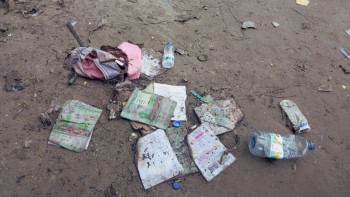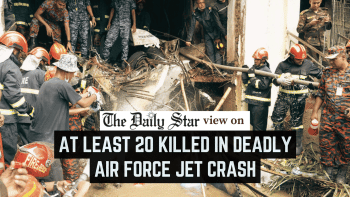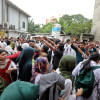Uttara air crash exposes deadly gaps

The death toll from Monday's tragic aircraft crash at Milestone School and College in Dhaka's Uttara has risen to 31 as of the latest count. At least 165 others also remain injured, as per the ISPR press release issued around 2:15 pm on Tuesday. As we have noted in our initial response, this is not the first tragedy involving air force training missions. While none has been as deadly, it is deeply alarming that few—if any—precautionary measures have been taken over the years to protect either military pilots or civilians from the risks posed by such exercises over a densely populated area like Dhaka.
In the aftermath of the crash, aviation experts as well as military and civilian pilots have rightly questioned the logic of allowing training flights over the capital. One expert pointed out that, given Dhaka's extreme population density, conducting such exercises here is far riskier than doing so in less populated regions where the air force also operates. Despite these dangers, air force aircraft continue to use the only runway at the Hazrat Shahjalal International Airport. Experts have long advocated for relocating the adjacent air force base, not only due to safety concerns but also because its operations often disrupt commercial aviation.
According to one air force pilot, flying in such a congested urban environment presents additional challenges. Flight paths should ideally be clear of buildings taller than one or two storeys, yet numerous high-rises now lie directly in their way. Unplanned urbanisation around the Dhaka airport—including the construction of schools, colleges, and shopping malls near approach paths—further complicates the situation. Pilots are forced to ascend rapidly and maintain higher altitudes, placing extra strain on their aircraft. Given the limitations of these machines, even a few seconds lost can prove critical.
Experts have questioned why such high-risk operations are still being carried out from Dhaka when alternative air force bases are available in Jashore and Chattogram. They have also criticised the Civil Aviation Authority of Bangladesh (CAAB) for failing to safeguard civilian passengers, whose safety is compromised by the continued presence of military flights at the capital's airport.
Another disturbing issue is the chaos prevailing at hospitals where injured victims were taken. Political leaders, journalists, and others were seen crowding these facilities, despite the fact that burn patients are acutely vulnerable to complications such as infections. How were so many unauthorised individuals allowed near the victims? What does this reveal about our emergency response protocols and disaster preparedness? Do the authorities have a comprehensive plan in place for such crises—or are we merely reacting in the face of a disaster?
These are questions that demand clear answers and prompt responses from the authorities. Most importantly, it is critical that this does not become yet another tragedy from which we learn nothing and allow history to repeat itself.


 For all latest news, follow The Daily Star's Google News channel.
For all latest news, follow The Daily Star's Google News channel. 










Comments